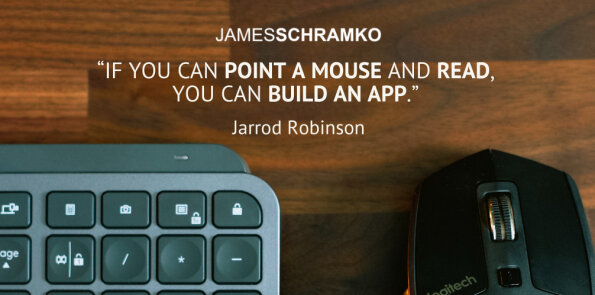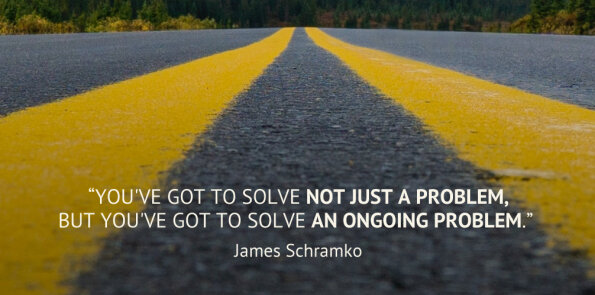Podcast: Download (Duration: 32:31 — 30.5MB)
Get Notified Of Future Episodes Apple Podcasts | Spotify | Amazon Music | Android | Blubrry | Gaana | TuneIn | Deezer | Anghami | RSS | More
James and The App Match’s Jarrod Robinson discuss how app creation has evolved, and the opportunities it opens for business owners.
Jarrod shares the process from concept to sale of an app.
He and James talk about the subscription element as it impacts an app-based product.
And they discuss how turning something free into an app can actually incentivize people to buy.
Table of contents
1. The road to selling an app
2. Providing a “no code” solution
3. Is it really as easy as an app?
4. From one-time solution to subscription
5. The matter of billing
6. The chocolate wheel versus the ascension model
7. Identifying the value proposition
8. Is it terribly expensive?
9. What else can you turn into an app?
10. How to bring about a sale
11. The business possibilities of app making
12. This episode in summary
The road to selling an app
Jarrod is James’s go-to guy for all things apps, having spoken on the topic many times on the show.
Now, Jarrod has recently sold an app, and James would like to discuss the takeaways from the experience, not the least being that it might be worthwhile to build an app you can sell.
Going back to the beginning, what caused Jarrod to create that particular app?
It was quite a long process, says Jarrod. When he first met James, he was selling the app as a standalone affair for 99 cents.
Interacting with James inspired him to turn it into a subscription in 2008. And really all it was was a toll that allowed teachers to track their attendance.
Jarrod remembers the first $8 of monthly recurring revenue it produced. Not big, but these things compound, and it snowballed from there.
The app grew without any marketing, and it made Jarrod think, wouldn’t it be nice to go through that whole process of spinning it out to someone else?
Two things that made that possible was the recurring revenue element, and that it solved a problem.
James is curious on that point – how did Jarrod find the problem to solve?
Scratching his own itch, Jarrod figures. He himself was a teacher.
Providing a “no code” solution
The next step would be determining the feasibility of an app to solve the problem. Straightaway people run up in their minds against the tech.
That brings up a buzz word of the moment: no code. Can Jarrod explain that?
All that is, says Jarrod, is that apps can be built with no code platforms now. If you can point a mouse and read, you can build an app.

The same thing is being done now for websites. Kleq, for instance, the platform James uses, is fully no code.
Is it really as easy as an app?
Now, James has heard someone claim that having an app is the easiest way to run a membership, easier even than Facebook. How true is that?
People these days, says Jarrod, can spin up a membership platform, a blog and a website, in a matter of clicks. They can create an app in the same way, and drive their audience to it.
Which is not to say that everyone should take that path, good as it sounds from a marketing perspective.
Some people, though, may have powerful content that they could repurpose quickly with a no-code builder into an app, and offer as a subscription product. It is an opportunity worth exploring.
In James’s case, most of his heavy users still use desktop. His membership, however, also comes with app access, which he feels is essential if you have any sort of desktop application or membership.
From one-time solution to subscription
What was it about changing Jarod’s product from one time to subscription that allowed it to work?
It was the fact that it solved an ongoing need. If you can identify a continuing problem your audience has, it warrants creating a micro subscription like the $1.99 per month offering Jarrod made.
You’ve got to solve not just a problem, but you’ve got to solve an ongoing problem, says James. As many know, he is a huge advocate of subscription business.

And with such a small price tag, there’s very little friction. Of course, you have to make a profit, but as long as your amount is less than the value of the solution, it seems fair value exchange, and users may hang around for quite some time.
The matter of billing
Is it using the Apple billing, asks James?
Yeah, says Jarrod.
A solid billing source, James says. He mentions it because PayPal has become somewhat less popular these days, for reasons he won’t go into.
Stripe is also popular, but you can run into issues when cards expire, or are lost or replaced.
It’s very, very easy to buy on the Apple platform.
Seamless, says Jarrod. And you don’t have to deal with refilling failure – Apple will do that as part of the merchant facility.
Sure, they take 15 percent if you earn less than a million dollars a year, and 30 if you make above that. But they take a lot of trouble off your shoulders as well.
The chocolate wheel versus the ascension model
In this instance, James and Jarrod are talking about a small price point, but over time it can be enough to make a car payment, or buy groceries or pay rent, which is exciting.
And Jarrod likes an analogy James spoke of in his book, the chocolate wheel, where one product offers a door to all your other products, and people can pick what they want.
This is in contrast to the ascension model, where people have to work their way up from the cheapest product to gain access to bigger-ticket items.
When someone wants to buy a Ferrari, says James, you don’t start them off with a bicycle.
That’s why Jarrod didn’t need sales funnels for his product, which became a door to his other offerings.
People listening might have an app in their wheelhouse they could leverage to sell higher-ticket stuff. And Jarrod knows someone who’s done this well is the Merrymaker sisters, with their library of recipes.
Identifying the value proposition
The Merrymakers gave away their recipes for free on their blog. So what was the value proposition behind putting them in an app?
There was the curation element, says Jarrod. People pay to have stuff curated. That might be all you need to create a micro subscription app.
And people need to eat, says James. Recipe creation and meal planning are hard to do, and people value that.
Bottom line, you may already have something that could become an app. What have you got that customers may need ongoing?
And it could be very easy to turn that into an app, with Jarrod’s help.
Is it terribly expensive?
How much could someone expect to pay for an app?
Jarrod has pricing on his site, TheAppMatch.com.
But it’s not 50 grand or 20 grand or 10 grand, asks James?
No, says Jarrod – you can literally get started now with your own no-code build, have a native iOS, Android, on the store, all the things that typically people would want, starting at $69 a month.
If that sounds absurd, it’s all because of the no-code kind of stack. App Match have the template, they’ve got all the plug-and-play elements.
All you need is to bring your content, your expertise, wrap it in an app, push it out to your audience, and go from there. And if you didn’t want to do it yourself, even though you certainly can, Jarrod and his team can do that part for you, and build it, and take your content and package it up.
What else can you turn into an app?
Jarrod has mentioned recipes. What other types of apps has he seen?
Lots of things, for sure. They’ve had experts in dry needling, who turned their content into a sort of reference book.
Jarrod deals with PE teachers, and has packaged PE games into another library of material. This stuff was typically a PDF.
A sleep expert took their sleep-related content, packaged it into videos, and made it almost a mini-course in app form.
Birthing material – anything your audience might value as content – and perhaps, most obviously, fitness material. If you’re posting it on YouTube and Instagram, why not turn it into an app and a subscription?
How to bring about a sale
Now someone saw value in Jarrod’s app and acquired it. How did that happen? Did someone knock on his door? Did he go out and list it for sale?
Jarrod had the idea of, would someone pay for this as a solution? And he saw evidence that they probably would – recurring customers, good growth, etc.
And he wanted to go through that process. So he found the website microacquire.com, which is a two-sided marketplace.
You’ve got buyers and sellers. And you can list your startup – you have to show evidence of its financials and all that sort of stuff, then people match.
And the good part about it is there’s no fees in the marketplace. Buyers pay to be able to view.
It means you’ve got serious buyers, because you can only see listings if you are willing to pay an annual subscription for it. And that basically automates the process.
Jarrod had people reach out to him, and it took two months of back and forth, but it was done. And now he thinks he just needs to do that with other apps that they have, because they’ve got more.
And of course, there’s scope there for people listening to do the same.
The business possibilities of app-making
Jarrod is prolific with his app-making – James can vouch for that. Can someone make a whole business out of this, finding people with a problem, solving it for them and then building these apps as a partner, JV, rev share, doing it as a service?
Definitely. Jarrod, for instance, is on social media, and sees a lot of people on TikTok and Instagram with vast followings and content – that could be fleeting, and why not build an app as a vessel to capture that value?
What about shops, gyms, retail stores, wholesalers, asks James?
Yeah. Jarrod knows of someone that’s used The App Match as a platform for their cafe, because one of the no-code features is a loyalty card built into the app.
And if you have a retail store, and you use the push notification features, someone walking past your venue can get a push notification, with some sort of a coupon offer. So it’s not just for an online audience. If you have a bricks and mortar, then there’s scope for that, too.
And the app can be free too, right?
It can be, and then they find a paywall, and they get subscribed to it. You can have your app as a one-off payment, $1.99, $2.99, whatever you think the value prop was, or you have it completely free, and simply capture the user registration, give away some epic value, but then in your marketing CRM, have some other sort of qualification process going on.
This episode in summary
James loves it.
So just in summary, you can build your own app, without code. You can solve a recurring problem with a subscription, or you can offer the app for free to build your database.
You probably already have the content you need. And an app can apply for just about any market, though there are some use cases that are much stronger than others.
What would be Jarrod’s biggest takeaway from this whole process?
The value of small microtransactions and how much they can stack up. People might dismiss them – I sell a $1,000 product, why would I bother with a 99 cent app? But this is an ecosystem with billions of people who don’t need to enter their credit card, simply use their face on Apple and Google, and they can make a purchase with you. And it’s probably quite smart to be involved in that ecosystem and grow with the demand.
No matter what you’re doing, says James, if you’re online, you need to have the ability to have app access.
Join like-minded, thriving entrepreneurs inside the James Schramko community
Liked the show? Enjoy all the episodes when you subscribe on iTunes









Leave a Reply